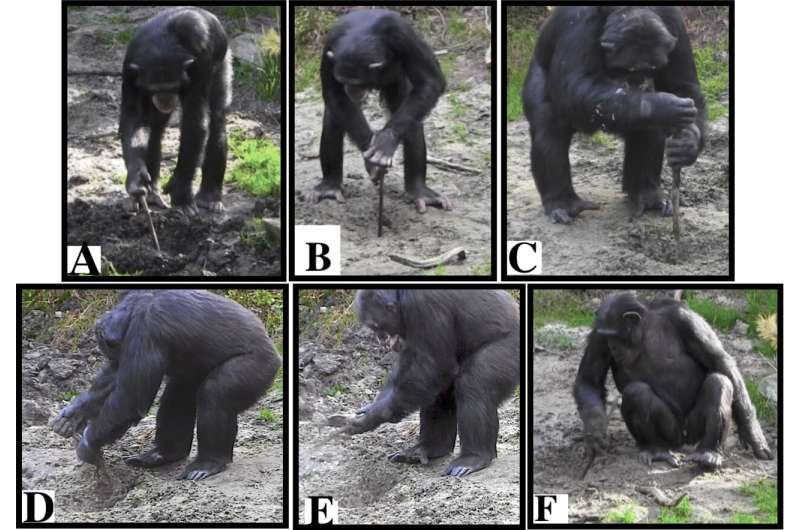Captive chimpanzees spontaneously use tools to excavate underground food

Chimpanzees in captivity can successfully work out how to use tools to excavate underground food, even if they've never been presented with an underground food scenario before, according to a study published May 15, 2019 in the open-access journal PLOS ONE by Alba Motes-Rodrigo and colleagues and directed by Adriana Hernandez-Aguilar from the University of Oslo.
Recent studies have indicated that wild chimpanzees and bearded capuchins are capable of using tools to excavate underground food such as plant roots, corms, and tubers—overturning earlier hypotheses that this type of tool use was unique to humans and their ancient hominin ancestors. In this study, the authors studied tool use and selection in captive chimps to further understand how food excavation behavior may have developed.
Motes-Rodrigo and colleagues monitored a colony of ten chimpanzees (Pan troglogytes) living on an island enclosure at the Kristiansand Zoo in Norway, eight of whom were born in captivity and none of whom had previously performed excavating behaviors. The authors dug five small holes and placed whole fruit in each, initially leaving the holes open to alert the chimpanzees to the fruit, and later filling in each hole. At first, the authors provided ready-made tree stick and bark tools; in a second experiment, they did not provide ready-made tools for excavation.
Nine of the ten chimps successfully excavated buried fruit at least once, with eight chimps choosing to use tools rather than their bare hands to do so. When the chimpanzees were not given ready-made tools, they collected their own tools from island vegetation. The authors observed the chimpanzees reusing particular tools as well as choosing long tools over shorter ones for excavation behaviors. In addition to noting six different types of excavation behaviors, the authors also observed chimps taking turns to excavate a hole, and even sharing the fruit once extracted.
The authors caution that results from captive chimps may not be exactly extrapolated to wild populations; and that modern apes should not be treated simply as "living fossil" stand-ins for hominin ancestors. Nonetheless, they speculate that early hominins may have worked out how to use simple tools to harvest underground food in a similar fashion to these chimps.
More information: Motes-Rodrigo A, Majlesi P, Pickering TR, Laska M, Axelsen H, Minchin TC, et al. (2019) Chimpanzee extractive foraging with excavating tools: Experimental modeling of the origins of human technology. PLoS ONE 14(5): e0215644. doi.org/10.1371/journal.pone.0215644
Journal information: PLoS ONE
Provided by Public Library of Science

















